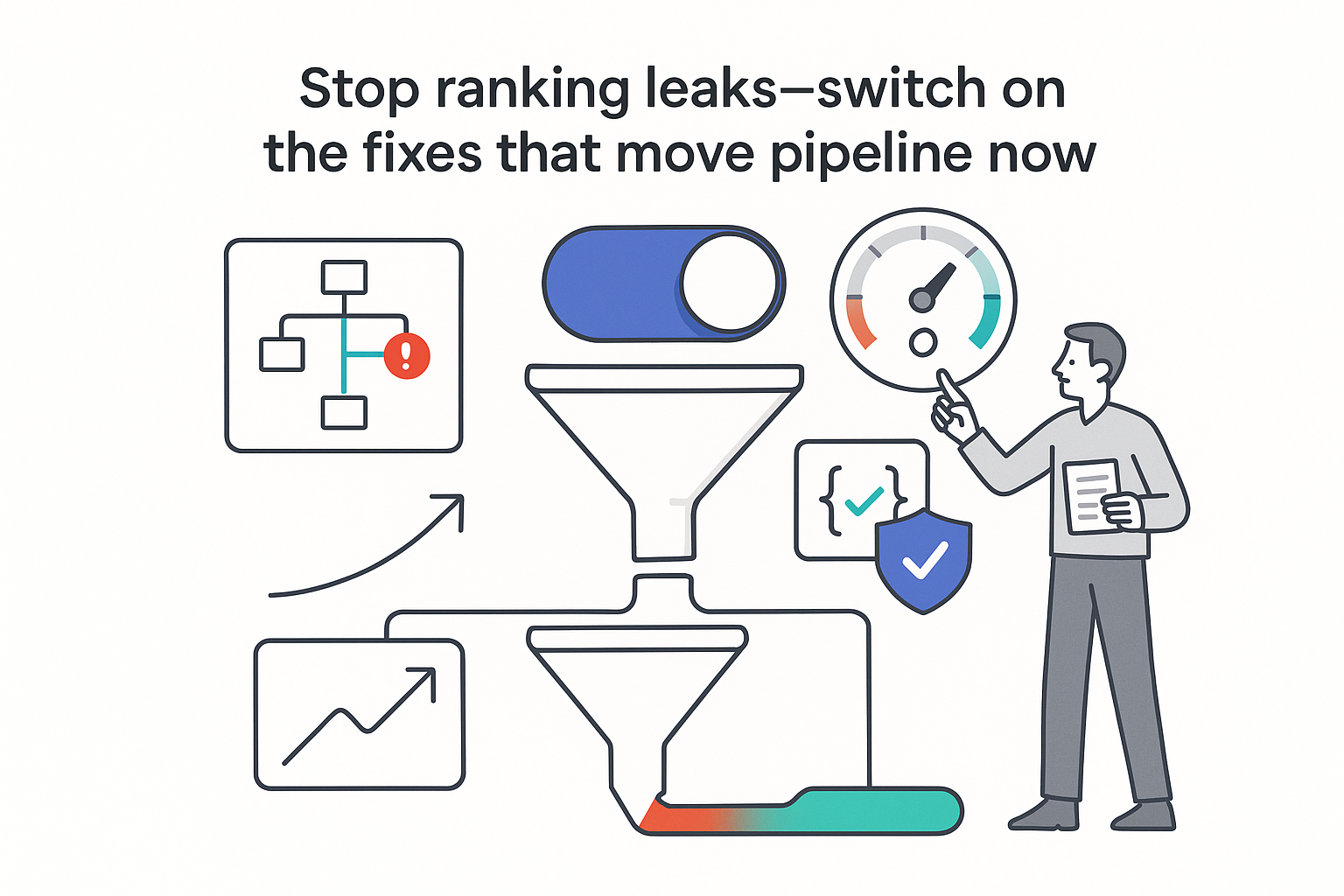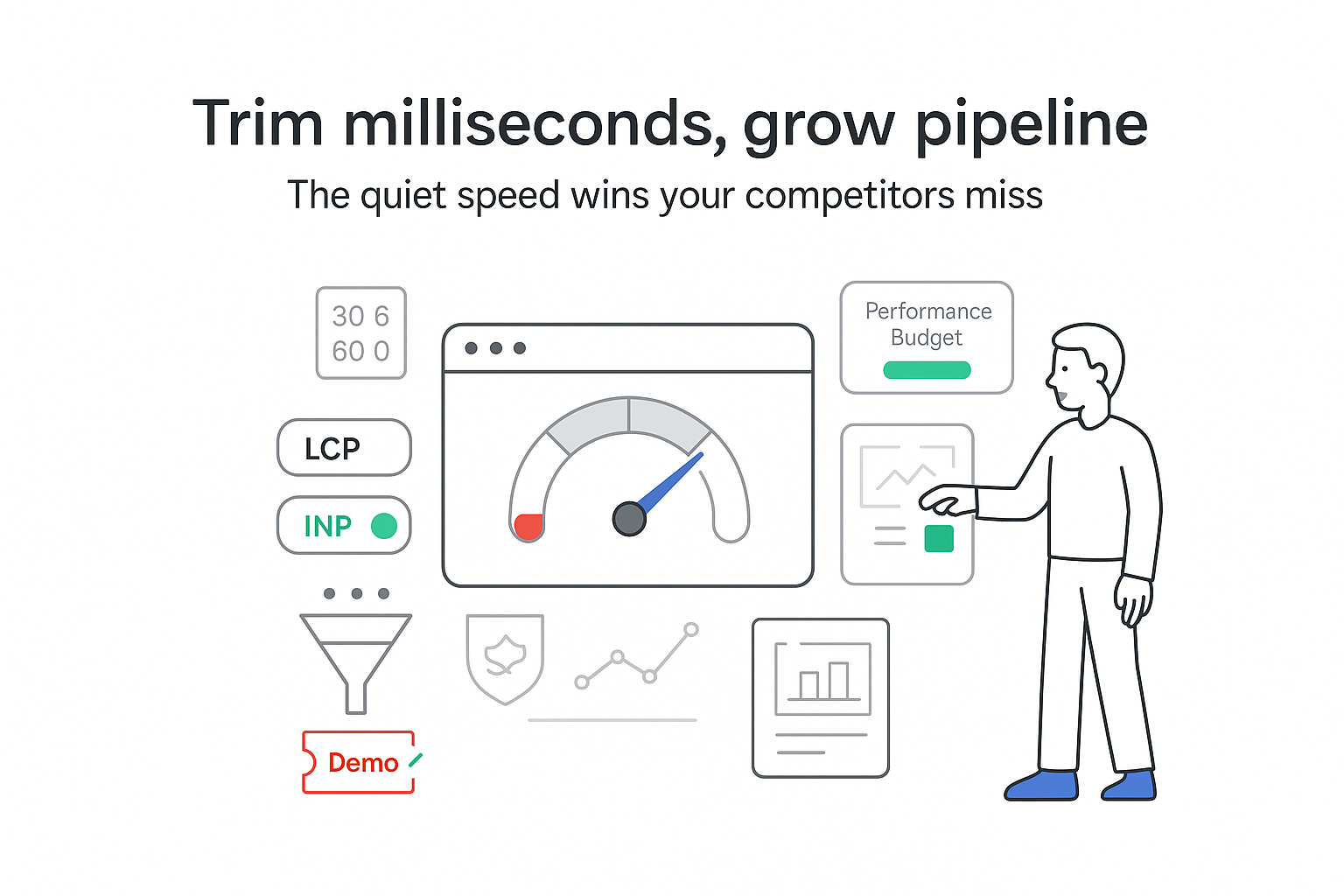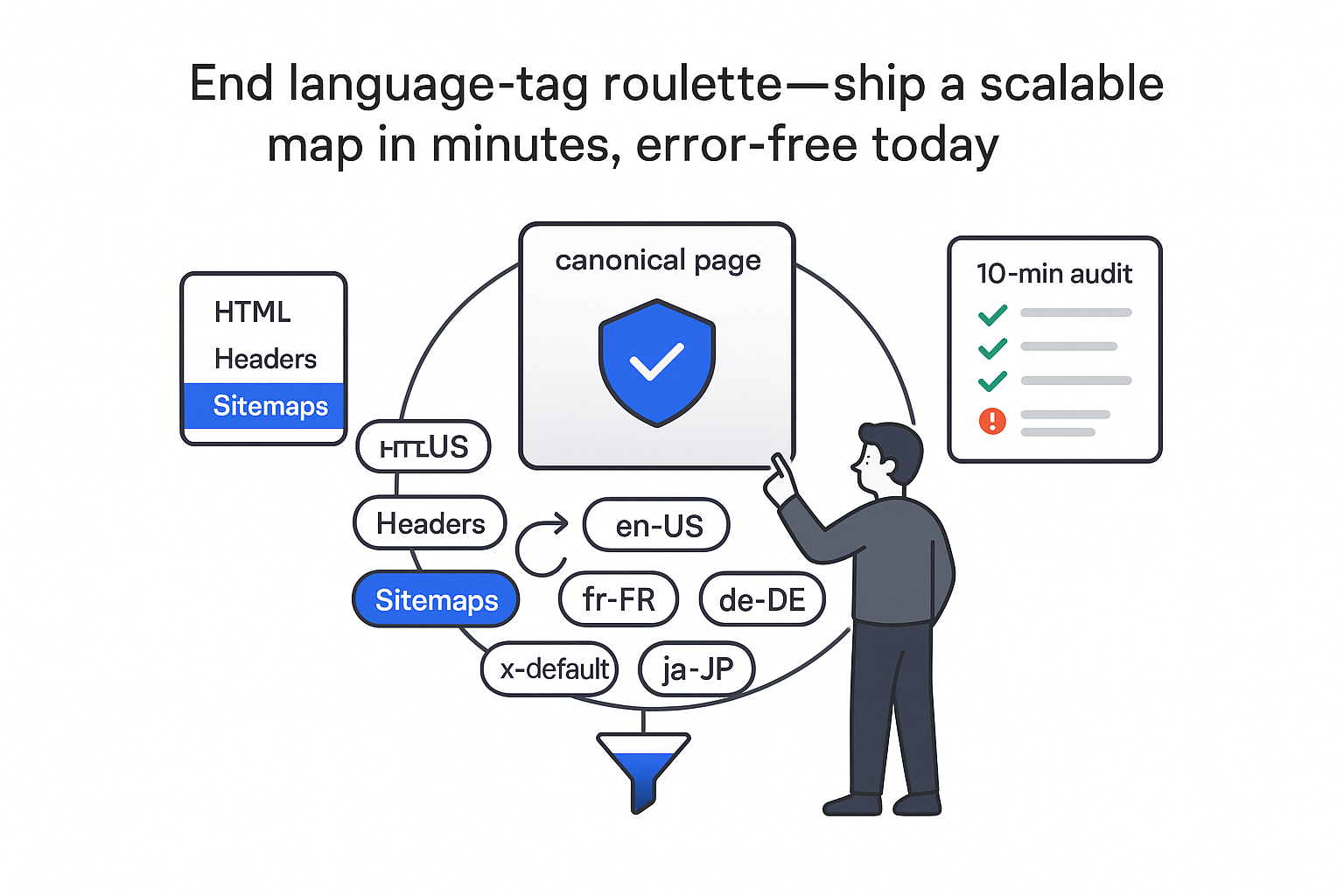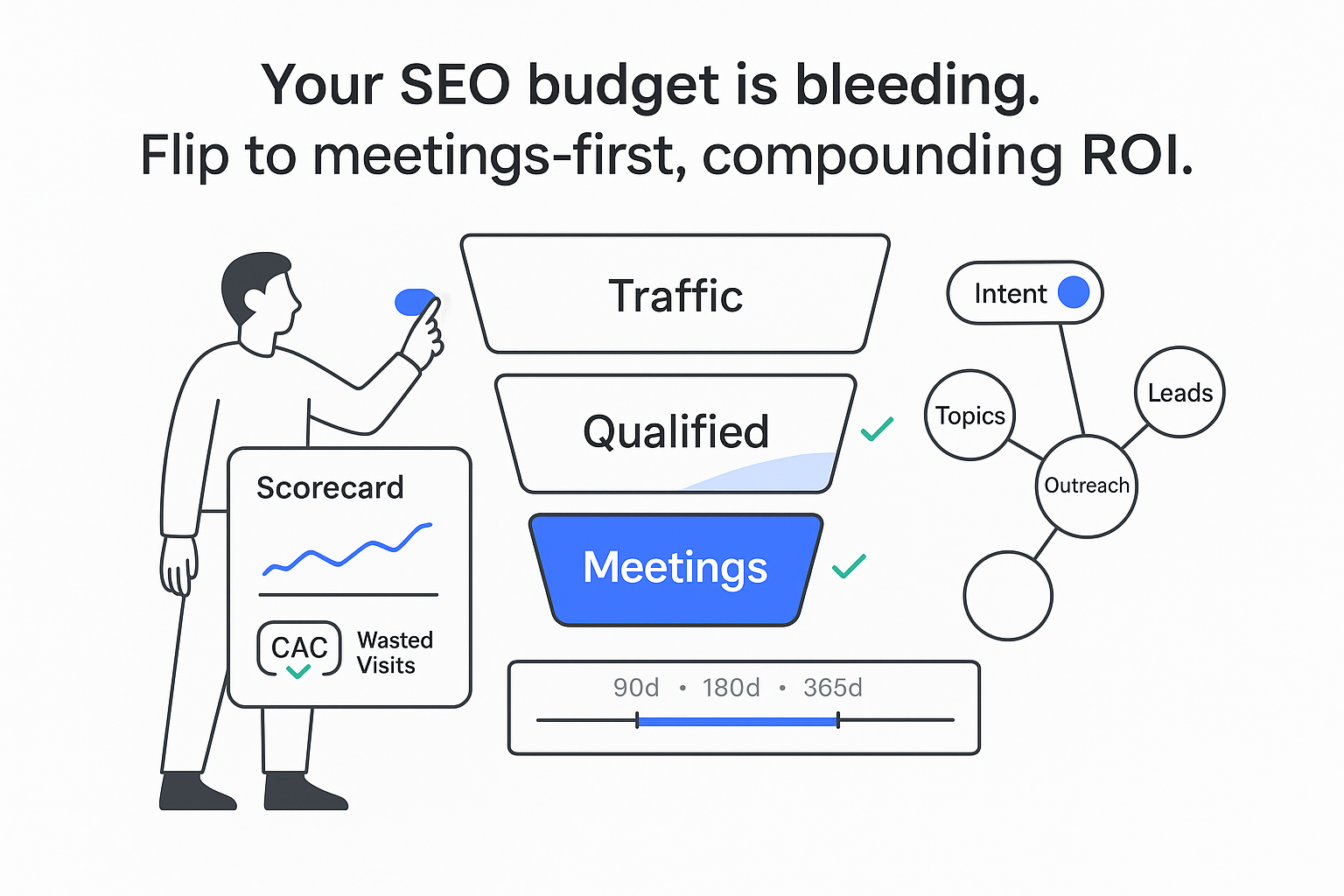Most CEOs do not need another SEO lecture. They need a plan that moves pipeline, lowers cost per qualified lead, and respects their time. That happens when search connects directly to sales motions. Start at the bottom of the funnel, make conversion effortless, and measure by revenue. Traffic is nice. Revenue is nicer.
A 90‑day roadmap that ties search to sales
I structure the first quarter around speed to value and clear handoffs into revenue.
- Weeks 1–2: Audit and quick wins. Fix indexation traps, redirect loops, duplicate titles, thin content, and messy canonicals. Submit a clean sitemap. Tighten on-page basics on top money pages by matching search intent, clarifying H1s, improving internal links, and aligning titles with buyer queries. Address obvious performance issues first - image compression, script deferral, caching, and mobile stability - so the first load is fast and layouts do not jump.
- Weeks 3–6: Build and prioritize bottom-funnel pages. Ship pages for high-intent terms: services by industry, pricing, competitor alternatives, integrations, and clear use cases. Instead of one-size-fits-all copy, create versions for each sector. Bring proof forward - case studies with numbers and quotes - and include pricing ranges if exact figures vary.
- Weeks 7–10: Strengthen internal links and authority signals. Build topic clusters around each core service with a flagship page, supporting explainers, and fresh proof assets, tied together with anchors that match buyer intent. Publish pages that answer tough objections - data handling, SLAs, compliance, AI policies, integration catalogs - and run light digital PR around credible research or insights to earn a few relevant links that actually matter.
- Weeks 11–12: Run CRO passes on top pages. Simplify forms, place social proof near CTAs, add calendar embeds for direct booking when appropriate, and test a small set of high-impact elements such as hero messaging, CTA order, and pricing qualifiers. Keep event tracking and CRM alignment in lockstep so wins are visible in revenue terms.
Why this approach improves pipeline quality
SEO influences pipeline quality because it captures active demand. When someone searches for a service plus pricing or an integration plus use case, they are not window shopping - they are signaling intent, timing, and often budget. That yields cleaner sales acceptance and fewer handoffs that stall.
This approach also aligns with what CEOs care about. Over a 6–12 month horizon, organic cost per qualified opportunity often trends below paid because content and rankings amortize while spend stays flatter. Results vary by ACV, cycle length, and brand strength, so treat ranges as directional. The work compounds: each page adds surface area for qualified queries and lifts related pages through internal links, creating a flywheel without extra media dollars. It is also defensible: a category-wide footprint across services, integrations, and industries cannot be outbid overnight.
Prioritize buyer-intent keywords
Start with queries that show purchase readiness and cluster them by how fast someone could buy.
- Service + provider/agency; service + pricing/cost/quote
- Competitor alternatives and [X] vs [Y] comparisons
- Best lists with clear criteria and a point of view
- Industry + service (for example, healthcare IT consulting)
- Integration and stack terms (for example, CRM integration + your service)
Group by commercial intent and speed to value, then build the highest-value cluster first. Deconstruct the SERP before drafting: if the winners are comparisons, build a real comparison; if they are deep service pages with FAQs, proof, and specs, match that format. Map one primary intent to one page - splitting a high-intent cluster across thin pages creates cannibalization and mixed signals.
Content that converts: structure, proof, and objections
On a bottom-funnel page, write as if a CFO is scanning on mobile between meetings. Above the fold should do the heavy lifting:
- A crisp headline that says what you do and for whom
- One short paragraph on outcomes - time saved, risk reduced, revenue gained - using ranges when exacts vary
- A primary CTA and a softer secondary action (for example, book a call or view a case study), both visible and simple
- Trust indicators that matter to B2B buyers - security, privacy, SLAs, partner programs
Handle objections before they come up. A transparent security page should outline certifications, data flows, PII handling, and incident processes. Implementation content clarifies roles, timelines, and ownership. Pricing content explains what drives ranges and why. Include the make-or-break questions buyers ask sales and answer them in plain language. For verticals and regions, localize copy to reflect compliance requirements, workflows, currency, time zones, and language, and use hreflang so the right version reaches the right audience. Use familiar B2B formats buyers expect - ROI explanations tied to value drivers, implementation guides, integration catalogs, and procurement notes that shorten legal and security reviews.
Trust and technical foundations
Trust wins competitive B2B SERPs. Make authorship and expertise visible with real bios, reviewer stamps on sensitive content (for example, security or methodology), and policy pages (security, privacy, SLAs, acceptable use, incident response) that are easy to find. Third-party proof - customer logos with permission, verified reviews, and relevant certifications - reinforces credibility. Cite sources for stats and keep dates fresh. Use structured data to clarify who you are and what the page contains. Apply appropriate Organization, Person, Service/Product, and FAQ/Review markup and validate it.
Technically, start with crawlability and indexation: clean sitemaps, correct robots rules, consistent canonicals, sensible pagination, and an architecture that mirrors topic clusters with shallow depth for revenue pages. If the site relies on heavy JavaScript, ensure content renders for bots on first pass. Improve page experience through image optimization, font loading strategies, preconnects, and smart caching, and confirm mobile parity. For multinational sites, hreflang and one canonical per language or region are non-negotiable. On large estates, review logs to see what crawlers actually visit, prune or noindex low-value pages, and focus crawl budget on what sells. Governance prevents messy rollouts: staging - QA - production with link checks, schema linting, form tests, monitors on key pages, and a rollback plan. Consent management and data retention policies should respect user choices and regulations.
Measurement that revenue teams trust
If it does not show up in the revenue view, it did not happen. Set KPIs that trace from query to pipeline and benchmark the conversion path so gains are visible and defensible.
- Rankings on bottom-funnel intent; high-intent form submissions or demo requests from organic; sales-qualified opportunities; pipeline dollars and closed-won from organic; and CAC payback for organic versus paid
- Directional conversion ranges to keep the team honest: 5–15% impression-to-click on bottom-funnel SERPs (SERP features and brand maturity matter), 1.5–4% click-to-demo on well-built landing pages, and 40–70% demo-to-SQL depending on fit and sales speed. Treat these as ranges to calibrate, not promises.
Keep a single source of truth by joining search data, web analytics, and CRM stages so first touch, last touch, and a simple multi-touch view are visible without vanity metrics. Time-boxed targets help set expectations: at 30 days, technical issues are addressed, first bottom-funnel pages ship, and tracking is stable. By 60 days, more high-intent pages are live and first meetings appear from organic. By 90 days, expect upward trends in bottom-funnel rankings, demo volume, and SQLs. By 180 days, meaningful pipeline dollars and lower cost per qualified lead versus month one.
Cohort views of each month’s new pages show how traffic, conversions, and pipeline compound over time, proving that past work keeps paying as new work starts. Stay disciplined: start with the money, fix friction fast, prove value with real proof assets, push authority via internal links to pages that sell, and measure what matters in the same frame sales and finance trust. That is how SEO stops being a lecture and starts being a pipeline engine.







.svg)